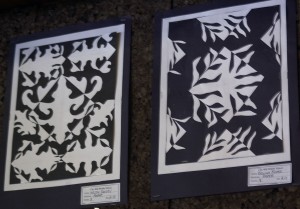
If music, as the poet Henry Wadsworth Longfellow once famously wrote, is the “universal language of mankind,” visual art is probably not far behind.
At least that seems to be Andrea Jakiela’s philosophy. The City Hill Middle School art instructor tries to impart a sense of multiculturalism to her students by including in the curriculum art projects reflecting various world cultures and styles, in addition to traditional Western art instruction. Here are some of her students’ wares.
African Kente cloths:

Known locally as nwentoma, the kente cloth is a type of decorative silk fabric native to Ghana. Jakiela’s students produced representations of kente cloths on paper using a reduction printmaking process. They cut “plates” out of Styrofoam and used them to produce the repeating geometric patterns.
Each color used in the kente project represents something, Jakiela said.
Red represents life and blood, blue is innocence, green is “mother Africa,” black means unity and people, and gold represents wealth and fortune.
Exploring the Japanese concept of Notan:

Students produced these cut-paper black and white collages to represent the Japanese concept of Notan, which Jakiela said is the idea of two opposites coming together to complete one another.
With this project, Jakiela said, students are “learning about another culture, dexterity, and balance—not just in their art but in themselves.”
She said she’s used a sports analogy to communicate the idea to students: A team’s offense and defense may play entirely opposite roles, but without one or the other, a team would be incomplete.
Buddhist/Hindu mandalas:

These circular, concentric diagrams have ritual and spiritual significance in both the Buddhist and Hindu traditions.
Jakiela said they represent “wholeness,” and the project teaches students how to incorporate both geometric and organic shapes into one work.
Carl Jung, the psychoanalyst, saw the mandala as “a representation of the unconscious self.”
In the Tibetan branch of Vajrayana Buddhism, the mandala form has evolved into intricate sandpainting. Monks may spend days or weeks creating complex mandala designs, but they then brush the sand together and pass it into a body of water as a meditation on the transience and impermanence of all things.
Puerto Rican vejigante masks:
These masks represent the confluence of African, Hispanic and indigenous cultures in the Caribbean.
They are worn during the Carnaval to celebrate the victory of St. James the Apostle, a patron saint.
According to Jakiela, the frightening facades are thought to scare away evil spirits as well.
Natively, the masks are made with coconut shells and, more recently, papier-mâché.













